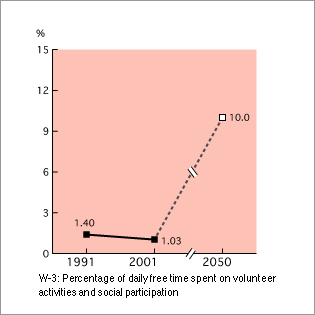ProjectsPast and current JFS projects
Indicators - Wellbeing / Citizen Participation
W-3. Percentage of daily free time hours spent in volunteering and social participation
1.Current Values1.03% (2001)
4 minutes (volunteer activities) / 388 minutes (time allowed for tertiary activities)
2.Current Points
(out of a perfect score of 100 by 2050) 10 points
Calculation method:
(Current value - minimum value) / (2050 target value - minimum value) x 100
3. Explanation of Indicator
The welfare and quality of life are supported and heightened by community sharing ("commons"). Although Japan has had traditional means of community sharing ("commons") such as yui (mutual assistance), kou (clubs and associations) and za (gatherings ), the post-war pursuit of efficiency and individualism has diminished the time spent in doing these activities, bringing about a breakdown in community. For the future, with human and cultural diversity increasing in localities, we encourage individuals to give a reasonable amount of time from their lives to build community, thereby heightening mutual welfare.
In the "Survey on Time Use and Leisure Activities" by Japan's Ministry of Internal Affairs and Communications, participation in civic activities is a part of the free time (tertiary activities) that exclude work, sleep and mealtimes, and JFS is using as an indicator the percentage of tertiary activities time spent on civic activities.
4.Target for 2050
10.0%
5.Ideal for the Future
10.0%
6. Rationale for Ideal and Target Values
Because volunteering and social activities are done on one's own initiative, it's impossible to determine an ideal value, but even from a global perspective an average of 4 minutes a day is an extremely low figure.
In the United States, where volunteer activities are well established, the daily average is 30.9 minutes (3.6 hours per week in the year 2000), and in Canada it is 26.6 minutes (162 hours per year, in 2000). In a full day of living, there are 6 hours and 28 minutes for tertiary activities (free time), excluding sleeping and eating (primary activities), and work, schooling, and household chores (secondary activities).
If we, for convenience, were to increase the time up to 40 minutes per day, slightly above the level of United Stats and Canada, that would be about 10% of free time, which is what we have chosen as our ideal for 2050.
7. Source
The Statistics Bureau of the Japanese Ministry of Internal Affairs and Communications "Survey on Time Use and Leisure Activities" (Japanese only)
8. Notes
"Volunteering" is defined as "contributing to society of one's free will by willingly offering one's skill and/or time" (Council for Lifelong Learning). Furthermore, it is "actions done of one's own accord, based on the motives of charity and service, self-fulfillment, mutual assistance, and reciprocity" (Council for People's Daily Life). As for the indicator we adopted here, "volunteering" is defined as "activities performed, not for the purpose of remuneration, but for the benefit of one's local society, individuals or organizations, through the offering of one's own labor, skills, and time".



